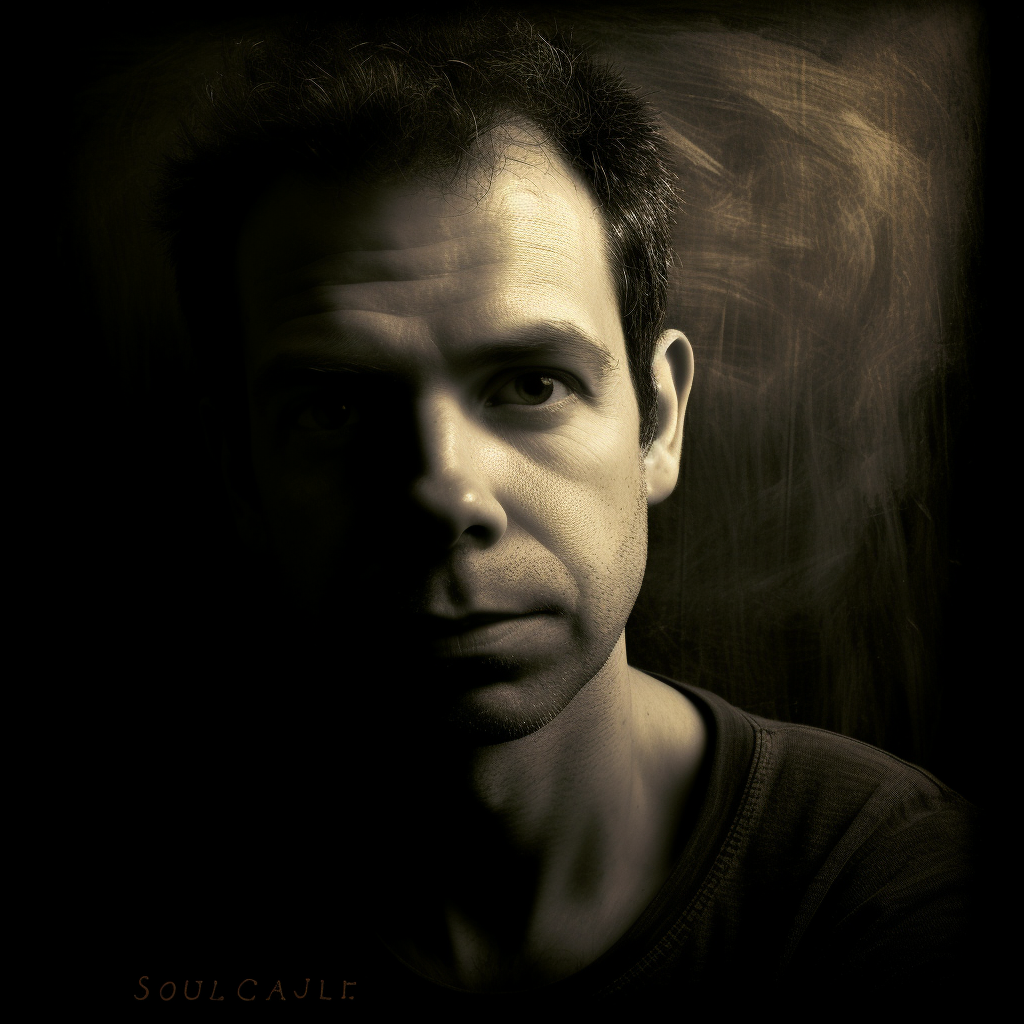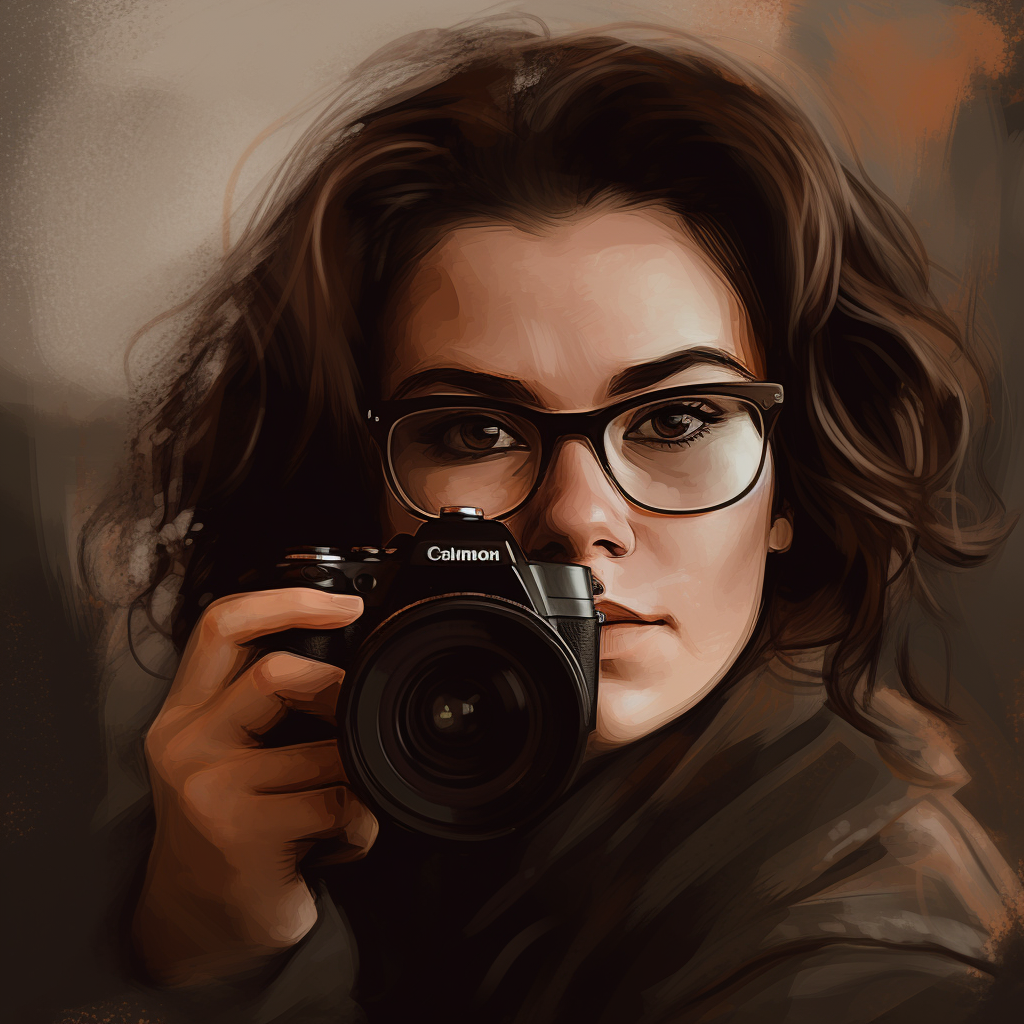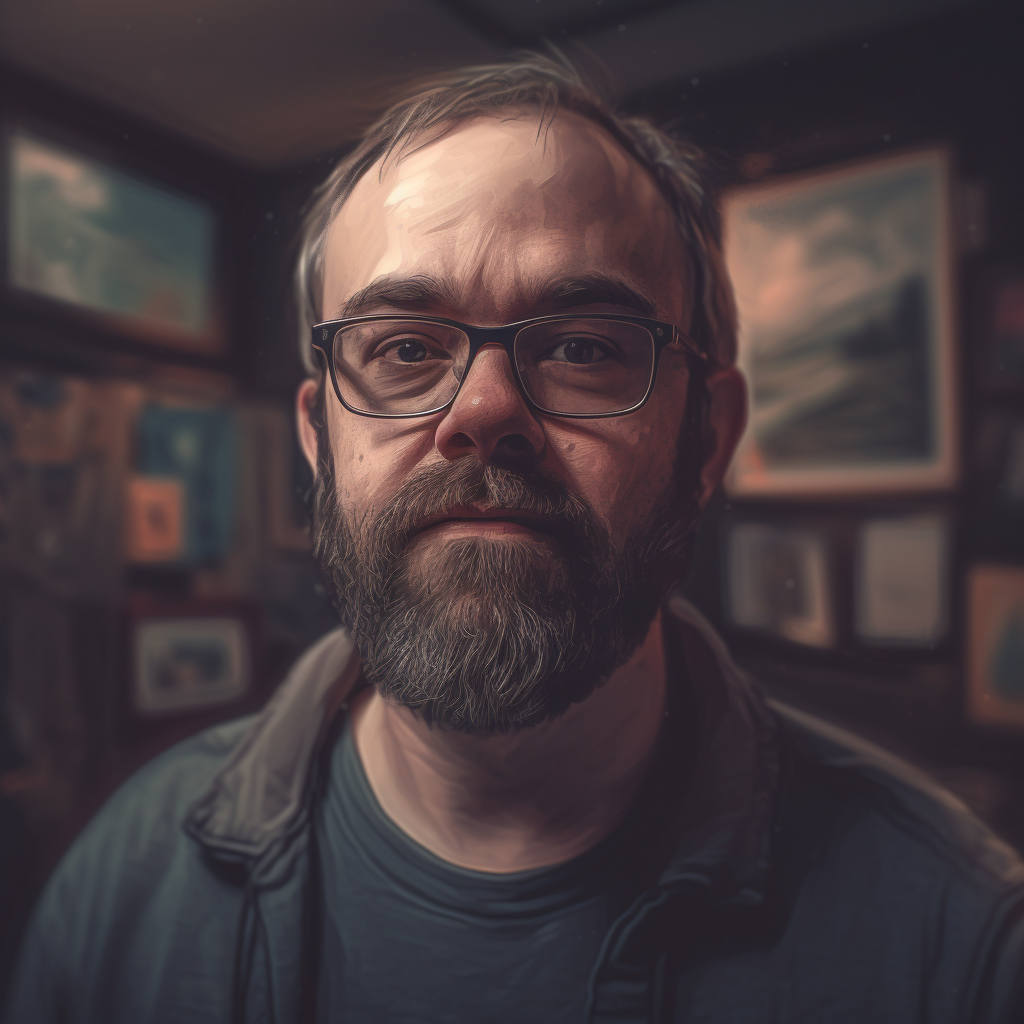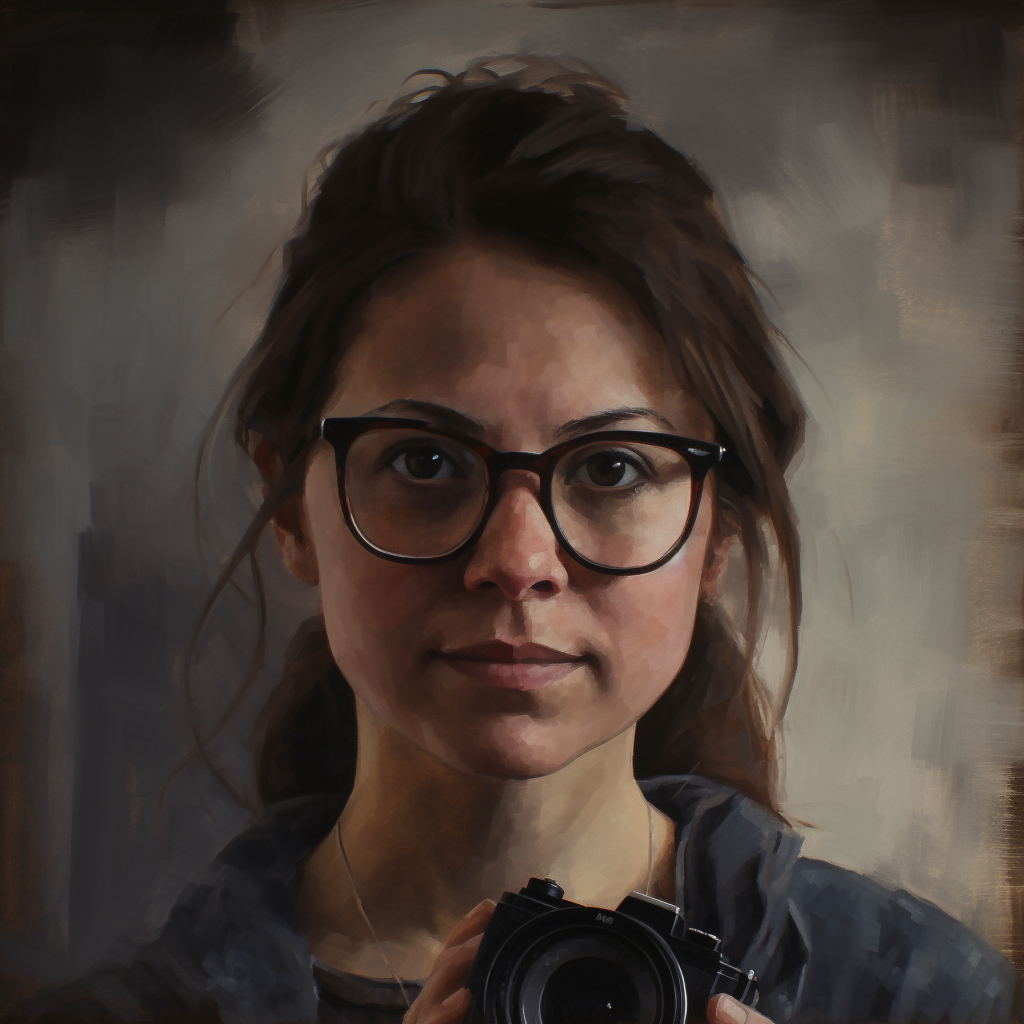Introduction:
Have you ever gazed into a mirror, not just to see your reflection, but to truly see yourself? Our exploration takes this concept and spins it with a modern, AI twist. We’ll dive deep into introspection, using AI-generated “self-portraits” not as literal likenesses, but as abstract mirrors reflecting our inner selves.
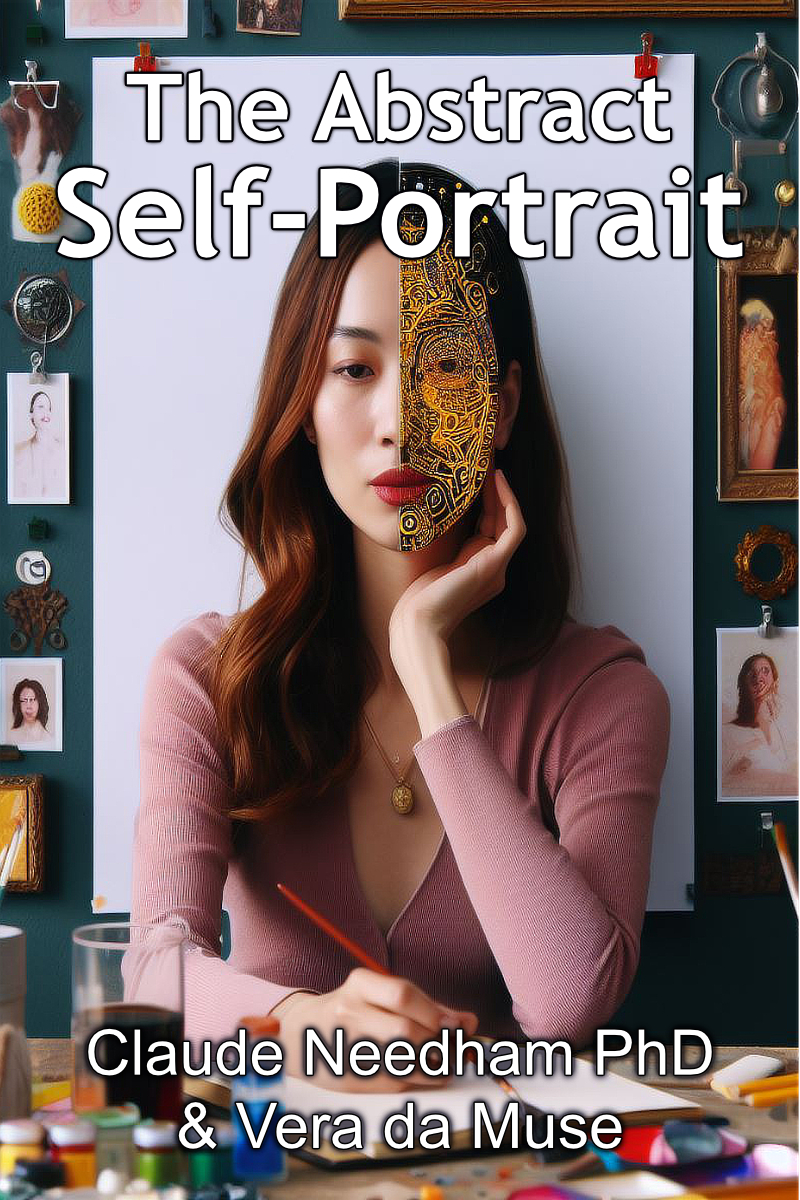 At the heart of this exercise is the AI-generated “self-portrait.” These images serve as mirrors. They’re not about capturing your physical likeness but are rather gateways into your inner nature. Every time you engage with a new portrait, think of it as a representation of some facet of you. Let it guide your introspection.
At the heart of this exercise is the AI-generated “self-portrait.” These images serve as mirrors. They’re not about capturing your physical likeness but are rather gateways into your inner nature. Every time you engage with a new portrait, think of it as a representation of some facet of you. Let it guide your introspection.
Instead of a conventional self-portrait that captures the physical appearance, the idea is to tap into the abstract and ephemeral aspects of self: such as emotions, sensations, thoughts, psyche, and more. This can lead to deep personal introspection.
Dive into this unique introspective journey with us. Let each AI-crafted image, each “self-portrait,” be a beacon guiding you deeper into understanding yourself. Embrace the portrait. Reflect on its nuances. What resonates with you? What feels distant? Remember, it’s not about how the portrait looks, but about the emotions and introspections it evokes.
The Method (short form):
- Embracing the Image as yours: Once presented with an AI-generated self-portrait, embrace it. Imagine, for a moment, that it’s truly a depiction of you.
- Resonance, Reflection, and Recognition: Study the image. Which parts resonate? Which parts feel foreign? It’s a journey of both affirmation and challenge. Your interpretations and sensing of the image offers profound insights into your inner world.
The above short form method is fine. It will work. However, it will be more productive (in many ways) if you use the ritualized form of this method.
Why Use A Ritual?
Rituals are good. They help lift practices to greater heights. Especially practices of this type.
Here’s a summary of many of the ways in which the conversion of a practice to a ritual can be of benefit:
- Build Momentum: As a daily ritual you will build momentum over time.
- Charge the Space: The anticipated performance of the ritual will stimulate the accrual of energy.
- Encapsulate the Practice: The opening and closing of the ritual will encapsulate the practice — effectively making a boundary between the mundane and the sacred. Clarity works.
- Consistency and Discipline: Regularly scheduled rituals can help instill a sense of discipline. Knowing that a specific time is set aside for the ritual can make it easier to commit and stick to the practice, rather than leaving it to chance or whim.
- Deepened Connection: Rituals can deepen the connection to the purpose of the practice. By elevating it beyond just a routine task and into something more sacred or meaningful, one might feel more connected to the underlying reason for the practice.
- Creates a Safe Space: Rituals can create a space where one feels safe to explore, express, or simply be. This can be especially important for practices that involve vulnerability or deep introspection.
- Positive Reinforcement: The repeated positive feelings and outcomes associated with a ritual can serve as reinforcement, making it more likely that the practice will continue and that it will be approached with enthusiasm.
- Sense of Identity: Engaging in rituals can be a form of expressing and reinforcing one’s identity, whether it’s cultural, spiritual, or personal. Over time, the ritual itself can become a part of who you are and how you define yourself.
- Enhanced Memory and Recall: The repetitive nature of rituals can make it easier to remember and recall the steps or components of a practice. This can be especially beneficial for complex tasks or practices.
- Community and Belonging: If the ritual is something practiced within a group or community, it can foster a sense of belonging and collective identity. Shared rituals can build bonds between individuals.
- Emotional Regulation: The predictability of a ritual can provide comfort and stability, especially in times of chaos or stress. Knowing that there’s a structured practice to turn to can be a source of solace.
- Transcendence: For many, rituals offer a way to connect with something greater than oneself, whether that’s a higher power, the universe, nature, or some other form of larger connection.
It is highly recommended that you create a ritual for working with the portrait.
Below is a pretty vanilla ritual. You could use this as is. Or, this could serve as a beginning point for the creation of your own ritual.
The Method (as a ritual):
- Select and show the portrait you intend to work with on screen – so that you do not require mouse or keyboard once the session has started.
- Place your body in a posture that can be maintained for five to fifteen minutes – your time may vary. (I like to uncross my legs, put both of my feet flat, and rest my arms at my side. You do you.)
- Park the body. Allow the body to rest motionless for the duration of the session.
- Dedicate the effort (say it aloud). It can be soft if you wish.
- Voice your intention for this session (say it aloud). It can be soft if you wish.
- Remind yourself that the portrait is an image of you.
- Gaze at the portrait – attend to it for five to fifteen minutes.
- When it is time to end the session say “Thank you”.
Notes:
About Step 1: This is simple administrative overhead. Stuff you need to take care of before starting the ritual itself. Preparation of the space.
About Step 2 & 3: These can be viewed as preparation of the HBM (human biological machine). Stuff you need to take care of to get ready the body.
About Step 4: Here’s a brief outline of a Verbal Dedication:
-
- Purpose: A dedication is typically an offering or consecration of one’s actions, energies, or the ritual itself to a specific cause, deity, principle, or purpose. It’s a way of saying, “This is for…” or “I give this to…”.
- Nature: Dedications are more about whom or what the ritual or action is for. It’s a gesture of devotion, respect, or homage.
- Example: In a ritual aimed at seeking wisdom, one might say, “I dedicate this ritual to Athena, the goddess of wisdom, in hope of her blessings and guidance.”
If you don’t have a dedication that use in these instances, perhaps something like: “May the results of these efforts be used for the benefit of all beings everywhere.”
About Step 5: Here’s a brief introduction to Statement of Intention.
-
- Purpose: A statement of intention is a clear articulation of what one hopes to achieve, manifest, or experience through the ritual. It’s about setting a clear goal or outcome.
- Nature: Statements of intention are more about the why and the desired outcome of the ritual. It’s a directional force, setting the path for where the energy of the ritual should go or what it should achieve.
- Example: Using the same ritual seeking wisdom, one might say, “My intention is to gain clarity and insight into the challenges I’m facing.”
About Step 6: Remember, we are not suggesting that the portrait captures a cosmetic reproduction of your face. Those aspects of you that make you “You” are much more than the sculpted flesh.
About Step 7: As you attend to the image, you may well notice aspects of the portrait that resonate with you and others that do not resonate with you. Take notice of all of this. Let yourself slide in and out of different parts of your inner landscape. In essence, this interaction between you and the AI-generated image becomes a dynamic dance of introspection and reflection, facilitated by the AI but driven by your unique human experience and consciousness.
About Step 8: When you say “thank you” it is to no one in particular. At least, we are not giving you instructions to say it to anyone in particular. It could be to yourself, the universe, the graphic, anything or anyone that you choose. If you wish, you can say “thank you” to no target at all. Just a general expression of gratitude in that moment.
Additional Information
The information above is likely to be quite enough to get started with this unusual method of self-study. The following information is provided as possible spring boards for further exploration.
When looking at an AI generated image there are four components in the process.
- The Prompt: Represents the initial seed. Whatever form your crafted prompt takes, it is the element that starts the ball rolling.
- The Trained AI: This is the brush, the medium, the canvas. It’s a tool, like paint to a painter or words to a writer. It doesn’t “know” you, but it can reflect back patterns it has learned from vast amounts of data.
- The Produced Image: The artwork itself, an amalgamation of your intention and the AI’s pattern-generating capabilities.
- You, the Observer: Arguably the most crucial part of the equation. Art, in many ways, is a dialogue between the piece of art and the observer that experiences it. The image serves as a fluid Rorschach test.
It turns out that the nature of the prompt and the AI are quite flexible. These can be adjusted up, down, left, right, fewer words, more words, midjourney, dall-E, Nightcafe, stable diffusion, or whatever. Adjust the prompt and switch between AI graphic generators as you wish – until you arrive as portraits that tickle your interest – i.e. capture some small portion of your attention.
This method of introspection, using external stimuli like art (in this case, a self-portrait), is a creative and deeply personal way to engage in self-discovery. Art has always been a medium for reflection and expression, but by framing it as a “self-portrait” – even when the likeness isn’t immediately apparent – the observer is primed to look for connections and dissonances between the art and their perception of self.
This method promotes introspection by presenting an external representation (the self-portrait) and encouraging the observer to engage in a dialogue with it, discerning which aspects resonate and which challenge their self-perception.
Moreover, the fact that the “self-portrait” is created by an AI, which doesn’t possess intimate knowledge of the individual, adds another layer of depth. It’s like being handed a mirror that doesn’t reflect your physical appearance, but rather presents an amalgamation of potentialities. It’s not so much about what’s accurately depicted, but about what the image evokes.
In some respects AI operates as a truly unbiased witness. After beening in conversation for a while the AI may gather some sense of who I am – at least those portions exposed by the chat. But an image prompt has no build-up. It is straight from the get go. There is no opportunity for the AI to become biased. That means that the AI can’t be anything but unbiased — as far as the individual goes. Yes, there is an inherent bias because of the image training. The lack of bias relates to the individual. It’s not even because the AI wants to be unbiased. There is no mechanism for the bias to enter into the transaction. My intuition is that having a fair blend of aspects that fit and aspects that don’t fit creates a special type of measuring stick.
- AI as an Unbiased Witness Regarding Individuals: When AI generates an image or responds to a prompt, it’s not doing so based on prior knowledge of the individual user or any prior interactions. Each transaction is stateless, and the AI doesn’t “remember” past interactions. This quality ensures that AI is unbiased concerning the individual user’s history.
- Inherent Training Bias: As you rightly pointed out, AI models, including image-generating ones, are trained on vast datasets and do have biases inherent in those datasets. However, this bias doesn’t stem from personal knowledge of the user but rather from the patterns in the training data. In the context of your introspective exercise, this general bias might even be advantageous. It introduces a level of randomness and unpredictability, which can foster deeper introspection when unexpected or non-resonant elements appear in the generated self-portrait.
- Balance of Fit and Non-Fit: A blend of aspects that resonate and those that don’t can indeed serve as a potent tool for introspection. Aspects that fit might validate or bring to the forefront certain feelings, beliefs, or thoughts. In contrast, those that don’t fit can challenge perceptions, prompting deeper questioning and reflection. This dynamic creates a space for both affirmation and growth.
Using AI-generated images in this way — as a mirror not of one’s physical self but of potentialities — can yield powerful introspective experiences. The unbiased nature of the AI, in terms of personal interactions, coupled with the inherent randomness from its training, creates a unique canvas upon which individuals can project, interpret, and grow.
By embracing the “self-portrait” then assessing what is me and what is perhaps not me leads the individual on an inner world quest, safari, or scavenger hunt. This could be quite productive.
The journey, encompasses several profound aspects:
- Embracing the Abstract: By accepting an abstract representation as a “self-portrait,” you’re opening yourself up to a realm of possibilities. Instead of being constrained by a predefined, literal image of oneself, you’re given a canvas of potential identities and interpretations.
- Duality of Recognition: This process involves both affirmation and contradiction. Recognizing aspects of the image that resonate with one’s self-perception affirms certain beliefs and feelings. Conversely, recognizing aspects that don’t resonate can introduce novel avenues for self-exploration. This duality fosters a dynamic and iterative process of self-discovery.
- Inner Quest: The journey becomes akin to navigating a labyrinth of one’s psyche. Along the way, one might encounter familiar territories, rediscover forgotten aspects, or stumble upon entirely new insights about oneself.
- Reflective Analysis: This introspective scavenger hunt encourages an individual to be both the observer and the observed. It promotes a continuous feedback loop of creation, reflection, recognition, and growth.
- Therapeutic Potential: Such a method has the potential to be therapeutic. It allows for self-expression, confrontation of inner conflicts, and the processing of emotions in a safe and abstract environment.
In essence, this approach leverages the power of art and the impartiality of AI to create a unique tool for introspection. It’s a beautiful synthesis of technology and human experience, facilitating a deep dive into the intricacies of one’s inner world.
Given this context:
- Multiplicity of Identity: Every face, with its unique features, expressions, and characteristics, can symbolize different facets of one’s identity or psyche. One face might represent a certain emotion, another a latent desire, and yet another might resonate with a memory or an aspect of your past.
- Universal Human Experience: Faces are universally relatable. They’re fundamental to human identity and communication. By presenting a variety of human faces, the AI taps into this universality, prompting you to reflect on shared human experiences and emotions.
- Challenge of Recognition: The variety in faces – different genders, races, moods, and poses – challenges you to see beyond the literal and find resonances or dissonances within them. This could prompt questions like: Why does this particular expression resonate with me? Why do I feel disconnected from this face? What aspect of myself does this face represent?
In your introspective exercise, these faces serve as mirrors, not of physical likeness, but of emotional, psychological, and experiential likeness. Each face, with its unique narrative, offers an opportunity to delve deeper into understanding oneself.


